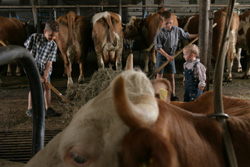Asthma protection in children brought up on farms
The prevention of allergies in animals can be achieved through the inhalation of microbial products. At present it is not certain if these findings can be extrapolated to humans. However, researchers have discovered that the children of farmers brought in up in surroundings rich in microbial matter form an ideal 'natural' model. This model can be used for studying the phenomenon of allergy prevention in people. The aim of the PASTURE project was to confirm the protective effect against asthma and atopy found in children growing up on farms. These children were compared to their peers who also lived in the countryside, but not on farms. The project also intended to determine the environmental factors that helped to bestow this protective effect. Questionnaires were used in the study, which also involved a clinical visit by the children at one year of age, and the analysis of blood samples. Environmental samples such as house dust and cow's milk were also examined. The fieldwork was carried out in five European countries. The research has provided a body of information regarding variation in the prevalence of atopic disease between children from farms and non-farm children in rural areas. This set of data is believed to be unique throughout the world. It has highlighted new insights into the role of lifestyle, genetic factors and other determinants. It has provided a great opportunity for future epidemiological studies. The project was able to confirm the protective farm effect identified in previous cross-sectional studies involving the PASTURE birth cohort. This was because the prevalence rate of asthma and atopy for parents and siblings were significantly lower for farming families than for non-farming families. When the PASTURE research team examined the factors behind this 'farm effect' they found that the exposure of mothers to farm animals and barns was of importance. It led to a difference in cytokine levels in cord blood between farm and non-farm children. Furthermore, non-farmers had higher levels of cord blood IgE antibodies to outdoor allergens, such as grass pollen. In contrast, farm children had higher levels of IgE antibodies to food allergens.







